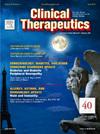泰国射频消融与肝切除治疗可切除小肝癌的成本-效果分析。
IF 3.6
4区 医学
Q2 PHARMACOLOGY & PHARMACY
引用次数: 0
摘要
背景:肝细胞癌(HCC)是泰国癌症死亡的主要原因。对于保留肝功能的早期HCC患者,肝切除术(HR)或射频消融(RFA)被认为是治疗选择。RFA适用于小肿瘤,理想范围≤3cm至≤5cm。也可以在不适合手术的病人身上进行。然而,像RFA电极这样的烧蚀设备的费用并不由国家卫生安全办公室(NHSO)承担,这限制了许多患者的使用。因此,本研究评估了RFA与HR在泰国治疗单个可切除HCC的成本-效果。方法:从社会角度使用马尔可夫模型进行成本效用分析,模拟40岁代偿性肝硬化(Child-Pugh A或B)和可切除HCC患者队列。比较两个患者亚组:单个HCC大小为3.1-5 cm和单个HCC≤3 cm。在整个生命周期内评估成本和结果,并以质量调整生命年(QALYs)衡量,采用3%的年贴现率。数据来源包括系统评价、国家数据库和地方医院。结果:对于≤3cm的肿瘤,RFA被证明比HR更具成本效益,每个QALY获得的增量成本-效果比(ICER)为11015泰铢(350美元),显著低于泰国的阈值160,000泰铢(5079美元)。RFA提供了7.55个QALYs,而HR提供了5.92个QALYs,每位患者的额外终身成本为24,922泰铢(791美元)。贴现率和随访费用显著影响ICER。对于3.1-5 cm的肿瘤,HR比RFA更有效(1.25 QALYs)和昂贵(21,294泰铢或676美元),使HR成为一个有利的选择。结论:在泰国,RFA应被视为≤3cm HCC的主要治疗方法,并应改变政策以支持器械报销。对于大小为3.1-5 cm的hcc, HR仍然是首选的治疗方法,因为它具有更好的生存结果和成本效益,除非手术不可行的。本文章由计算机程序翻译,如有差异,请以英文原文为准。
The Cost-Effectiveness Analysis of Radiofrequency Ablation Compared to Hepatic Resection for Resectable Small Hepatocellular Carcinoma in Thailand
Background
Hepatocellular carcinoma (HCC) is a leading cause of cancer death in Thailand. For early-stage HCC patients with preserved liver function, hepatic resection (HR) or radiofrequency ablation (RFA) are considered curative options. RFA is suitable for small tumors, ideally ≤3 cm and up to ≤5 cm. and can be performed in patients who are unfit for surgery. However, the cost of ablative devices like the RFA electrode is not covered by the National Health Security Office (NHSO), limiting access for many patients. Thus, this study evaluates the cost-effectiveness of RFA compared to HR for single resectable HCC in Thailand.
Methodology
A cost-utility analysis using a Markov model was conducted from a societal perspective, simulating a cohort of 40-year-old patients with compensated cirrhosis (Child-Pugh A or B) and resectable HCC. Two patient subgroups were compared: those with single HCC sized 3.1-5 cm and those with single HCC ≤3 cm. Costs and outcomes were assessed over a lifetime horizon and measured in quality-adjusted life years (QALYs), with a 3% annual discount rate applied. Data sources included systematic reviews, national databases, and local hospitals.
Results
For tumors ≤3 cm, RFA proved more cost-effective than HR, with an incremental cost-effectiveness ratio (ICER) of THB 11,015 (USD 350) per QALY gained, significantly below the Thai threshold of THB 160,000 (USD 5,079) per QALY gained. RFA provided 7.55 QALYs versus 5.92 QALYs for HR, with an additional lifetime cost of THB 24,922 (USD 791)per patient. The discount rate and cost of follow-up significantly impacted the ICER. For tumors 3.1–5 cm, HR was more effective (1.25 QALYs) and costly (THB 21,294 or USD 676) than RFA, making HR a favorable option.
Conclusion
RFA should be considered a primary treatment for HCC ≤3 cm in Thailand, with policy changes to support device reimbursement. For HCCs sized 3.1–5 cm, HR remains the preferred treatment due to better survival outcomes and cost-effectiveness unless surgery is not feasible.
求助全文
通过发布文献求助,成功后即可免费获取论文全文。
去求助
来源期刊

Clinical therapeutics
医学-药学
CiteScore
6.00
自引率
3.10%
发文量
154
审稿时长
9 weeks
期刊介绍:
Clinical Therapeutics provides peer-reviewed, rapid publication of recent developments in drug and other therapies as well as in diagnostics, pharmacoeconomics, health policy, treatment outcomes, and innovations in drug and biologics research. In addition Clinical Therapeutics features updates on specific topics collated by expert Topic Editors. Clinical Therapeutics is read by a large international audience of scientists and clinicians in a variety of research, academic, and clinical practice settings. Articles are indexed by all major biomedical abstracting databases.
 求助内容:
求助内容: 应助结果提醒方式:
应助结果提醒方式:


